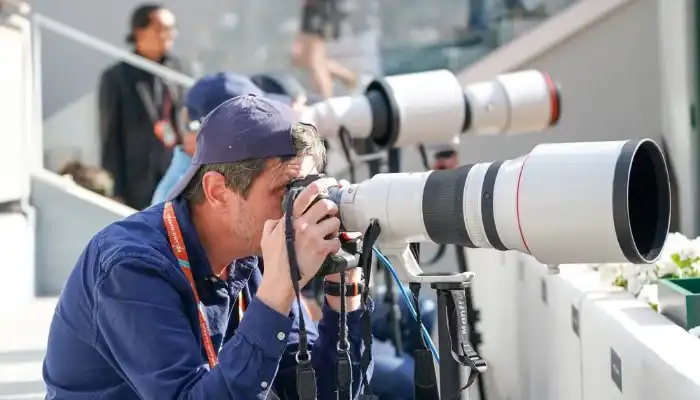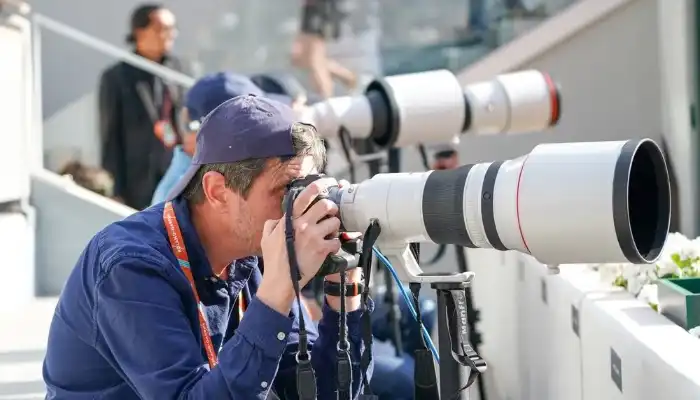
Sports photography is an enticing and captivating field of art that captures the raw energy, athleticism, and drama of sports.
From the adrenaline-inducing intensity of a dunk in basketball to the resolute determination of a marathon, sports photographers possess the unique ability to narrate stories with only one image. However, performing such transient athletic stunts requires more than just pointing a camera and pressing the shutter button. It calls for comprehensive knowledge of your camera equipment, mastery of composition techniques, perfect timing, and adaptation to ever-changing lighting conditions.
The all-inclusive guide will provide you with the necessary skills and information that can help elevate your sports photography. Whether you are experienced or just starting, there is always room for improvement. So grab your camera metaphorical shoes and dive into the exciting world of sports photography!

Understanding Your Gear: The Tools of the Trade
Before heading out to the field, it’s important to have deep knowledge about your camera equipment.
• Getting Familiar With Your Camera: Take time to get familiar with your camera’s functions and settings. Experiment with different modes, try menu options, and learn how each setting affects your photos.
• Choosing The Right Lens: The right lens can make all the difference in sports photography. Telephoto lenses save you much by letting you zoom closely into action from long distances. When selecting a lens, take focal length, aperture, and image stabilization into consideration.
• Mastering Camera Settings: Depending on what sport you are photographing, you will need to adjust your camera settings accordingly. In high-speed games like hockey or soccer, a fast shutter speed would be vital for freezing action, while slow shutter speeds could be used in other games such as cycling or gymnastics, which tend to capture motion blur sometimes. Aperture settings vary the depth of field, thereby enabling the exclusion or inclusion of background objects.
Mastering Composition Techniques: The Art of the Frame
How you compose your shot has great significance when it comes to storytelling as well as visual impact.
• The Decisive Moment: The reason why sports photography is so amazing is because it captures the pinnacle of action—that split second when everything comes together for a powerful image. Work on your ability to anticipate and be ready to capture that instance of perfection in motion.
• The Rule of Thirds: This fundamental rule suggests dividing the frame into a 3×3 grid. When you place your subject at the intersection points of these lines, it creates a more dynamic as well as visually pleasing composition.
• Leading Lines and Framing: In soccer fields, sidelines or the track on a running course can act as leading lines that can draw the viewer’s eye straight into the action. Use framing techniques such as panning with a subject or incorporating foreground elements, which provide some depth and context to your pictures.
Perfecting Timing and Anticipation: A Race Against Time
Sports photography is all about time. Here’s how to stay ahead:
- Become One with the Action: Few things excite sports photographers like having an almost psychic ability to predict what is about to happen next. Watch athlete movements become familiar with the game flow and be alert enough to take a shot just before it unfolds.
- Professional Peak: Capturing the peak of action is vital whether it be a baseball player hitting with perfect precision or an athlete crossing the finish line in victory. Learn to follow your subject and press the shutter button immediately at the decisive moment for maximum results.
- Continuous Shooting: Your Best Friend: Most modern cameras have modes that can shoot continuously and take several shots per second. This will ensure you never miss that one golden moment! Know how to effectively use burst mode to increase chances of capturing peak action.
Utilizing Light to Your Advantage: Illuminating the Game
Lighting affects sports photography significantly. Here’s how to handle different situations:
- Understanding Light: Understand where light is coming from and its intensity. The scorching midday sun creates visible shadows while overcast skies make everything flat. Acquire knowledge on how to use available light and adjust settings according.
- Shooting in Different Environments: Outdoor sports come with a different set of challenges compared to those played indoors. For example, you need skills to contend with blazing sun, artificial stadium lights, or even darkness during night games.
- Harnessing the Power of Light: Try different types of natural and artificial lighting without fear. Employ reflectors when shooting under trees or using strobes for creative lighting effects.
Beyond the Lens: Understanding the Sport
Technical expertise is just one part of being a photographer; understanding sport can give you an advantage when taking photos.
- Knowing the Rules and Dynamics: Get familiar with game rules, positions during play, and general flow from which key moments emanate as well as movement by players during this time to take better pictures by being ready during these action-packed seconds; just think about a footballer who is about exerting all his energy on goal post then understand what he does after scoring – you are now in a good position for shooting such moments.
- Anticipating Key Moments: Each sport has its crucial moments: a quarterback dropping back into the pocket to pass, a tennis player winding up for a serve, or a basketball player about to dunk. You will be well positioned to capture these significant instants if you understand the cadence of the game.
- Adjusting Your Approach: The approach varies from sport to sport. Marathon photography is about capturing endurance and persistence, while basketball requires you to shoot in short bursts documenting dynamic movement. Change your photographic approach and lenses as suited by the particular sporting event being documented.
Finding the Perfect Angle: Positioning and Movement
The perfect shot is all about being at the right point and moving calculatedly.
- Importance of Vantage Point: Try changing your shooting height – take pictures from down below when you want an amazing view of a jumping player or panoramic shots of large grounds taken from high points or even goal shots from behind for penalty kicks.
- Techniques for Moving Around: Do not stand still when photographing sports! Move along designated areas tracking action and taking photos from various angles.
- Using Different Angles: Shake things up with creative photo angles.
- Low Angle: When you lower your camera to the ground, nothing captures the energy and power of athletes better. It is also superb for football (with emphasis on a lineman breaking through a tackle), volleyball (showcasing the spiking of the ball by a player), or gymnastics (emphasizing jump height).
- High Angle: For broader coverage, move to higher elevations such as stadium seats or press boxes. This can best show the team formations in games like soccer or American football, or capture overall audience excitement after scoring.
- Dutch Tilt: This shooting technique involves tilting the camera slightly off-center to create action and instability. Although not applicable in all situations; it’s useful when an intense game must be portrayed or when an athlete is aggressively trying to reach their limits.
- Background Manipulation: The mood and story of your photo are significantly affected by the background. Look for interesting backgrounds that match with what is going on. To further illustrate this point, sometimes a blurry crowd may serve as a proper setting for an athlete’s performance whereas photographing imaged colorful team banners at someone at his back will bring out more meaning about the game.
The Final Touches: Post-Processing and Editing
In-camera perfection while desirable, post-processing software can give your sports photos new dimensions.
- Importance of Post-Processing: Basic editing makes noticeable improvements to photographs. Other adjustments include cropping, correcting exposure settings, balancing white conditions, and sharpening images which make them appear brighter with more details.
- Basic Editing Techniques: Most editing software offers tools for basic adjustment purposes. Play around with cropping to change composition size reducing extraneous objects from images, changing exposure so that pictures come in darker or lighter than others colors within them are correctly represented, as well as sharpening areas like facial expressions and jerseys on athletes during play.
- Maintaining Authenticity: Editing should enhance the photo but at the same time keep it authentic. Try to avoid excessive manipulation that completely changes what transpired in a scene. This is meant to enhance rather than create an imaginary representation of the event.
Learning and Growing: Continuous Improvement
Becoming a proficient sports photographer is an ongoing process of learning and evolving.
- Importance of Feedback: Seek criticism from your colleagues, photography forums, or even professionals. A different view can help you find areas for improvement and get better at how you take photos.
- Dedication to Practice: The more you shoot, the better you’ll become. Volunteer for local sports events, attend professional games, or try taking action shots in your yard. You need to put yourself out there and try new things.
- Learning from Experience: Every shoot serves as a study session for you. Analyze your past photos, identify your successes and failures, and use that knowledge to improve your approach for future events. Dare to experiment – it’s through this that we find our unique photographic voice.
Conclusion
Sports photography is an exciting challenge that combines technical expertise with creative vision and respect for athletic spirit. By mastering these key techniques discussed in this guide, capturing stunning sports images displaying anger, determination, and happiness will become easier for you too! Get ready with your camera; go out on the pitch area so that you may adventure into thrilling sports photography-related incidents!
